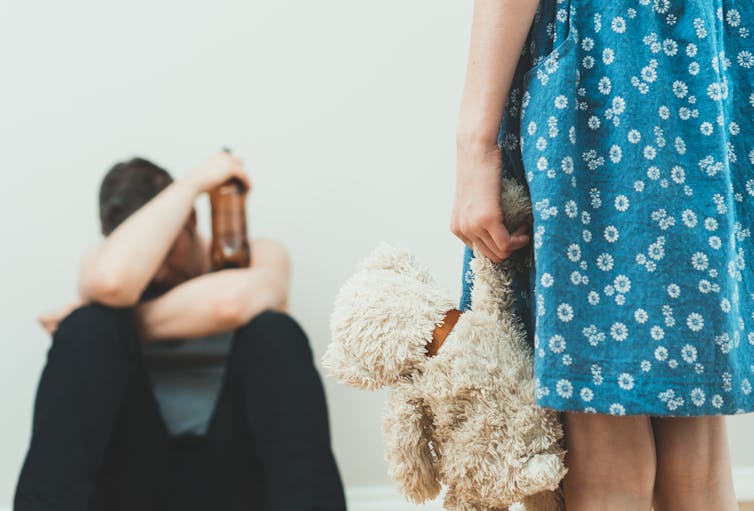Source: The Conversation (Au and NZ) – By Taisia Huckle, Associate Professor in alcohol policy, Massey University

Getty Images
More than one in ten children who are maltreated suffer because of the second-hand effects of alcohol, according to our recently published research.
This is the first national cohort study in Aotearoa New Zealand focused on child maltreatment among children under 18 and alcohol use by adults caring for them. We estimate at least 11% of maltreatment could be due to hazardous or severe drinking among carers.
This is also the first study globally to examine all five domains of child maltreatment – physical abuse, neglect or abandonment, emotional or psychological abuse, sexual abuse and exposure to family violence – using data from child protection, hospitals and police linked to hazardous or severe alcohol consumption among parents.
Our findings show children exposed to this level of drinking among their caregivers have a 65% increased risk of maltreatment. But current alcohol policy does not reflect this. We argue it could play an important role in the prevention of harm to children.
Alcohol and the risk of child maltreatment
Carers who drink may be less vigilant, or cause conflict or violence. It is important to reduce this harm, given children are largely unable to remove themselves from the harmful environment.
We analysed data from 58,359 children aged 0–17 and their parents, from 2000 to 2017. Parents with hazardous or severe alcohol use were identified from hospitalisations or their use of mental health and addiction services, including community services.
Across all five domains of child maltreatment, 14% of children experienced at least one maltreatment event. This percentage was as high as 34% for emotional abuse. The next most common types were neglect and exposure to family violence in the household, both around 20%.
Hazardous or severe alcohol consumption among parents increased the risk of child maltreatment by 65%.
Read more:
Major study reveals two-thirds of people who suffer childhood maltreatment suffer more than one kind
The burden of alcohol on child maltreatment
We also analysed data from one year – 2017. We found between 11.4% and 14.6% of child maltreatment could be due to hazardous or severe consumption among parents. This impact of alcohol on maltreatment is similar to traffic crash deaths caused by others drinking (13%), highlighting the size of the problem.

Shutterstock/M-Production
Hazardous alcohol exposure is involved in child maltreatment as part of a cluster of precipitating factors. This often reflects other types of adversities families experience.
In our study, the risk of child maltreatment was greater for children born into a family with already existing adversities, such as heavy use of other drugs, mental health issues or the mother’s age at childbirth.
If a family had a history of hazardous drinking, this accrued more risk for maltreatment than if the family developed alcohol problems as the child was growing up. Children from families with low education status had almost five times the risk of maltreatment, relative to families with high education status.
We argue alcohol policy has a place in preventing child maltreatment related to alcohol. It is critical children receive more attention in the alcohol policy debate.
We know from previous research that increasing tax on alcohol, banning or reducing alcohol marketing and reducing the availability of alcohol will work to reduce heavy drinking among adults. This can, by default, protect children from the second-hand effects of alcohol.
These policies are cost-effective in reducing harm from alcohol and do not further burden child protection services.
Lack of health regulations for alcohol
There are challenges implementing effective alcohol policy. We still don’t have any internationally binding health regulations in place for alcohol. Alcohol remains the sole major addictive substance without such oversight.
The structure and practices of the alcohol industry, as with other industries producing and marketing unhealthy products, also play a crucial role in this challenge.
The primary source of contention between the alcohol industry and the public health community stems from the industry’s reliance on heavy consumption for sales and profits. This conflict of interest is a powerful motivator for industry interference in both effective policy development and implementation.
Nevertheless, children have rights to be protected from maltreatment (Article 19 of the UN Convention on the Rights of the Child). Good public policy can reduce some of the burden of alcohol on child maltreatment, and also lessen prenatal exposure to alcohol and fetal alcohol spectrum disorder.
![]()
Taisia Huckle receives funding from The Health Research Council of New Zealand.
Jose S. Romeo does not work for, consult, own shares in or receive funding from any company or organisation that would benefit from this article, and has disclosed no relevant affiliations beyond their academic appointment.
– ref. Study reveals at least 11% of child maltreatment in NZ could be due to heavy drinking by caregivers – https://theconversation.com/study-reveals-at-least-11-of-child-maltreatment-in-nz-could-be-due-to-heavy-drinking-by-caregivers-204113







